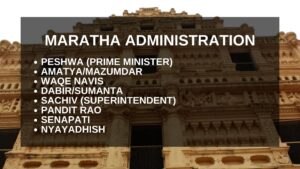The Maratha Empire, which flourished from the 17th to the 18th century, played a pivotal role in shaping Indian history. It was known for its formidable military strategies, innovative governance, and relentless resilience against foreign invasions.
The rise of the Marathas in the Deccan was initiated under the visionary leadership of Chhatrapati Shivaji, who laid the foundation of a strong empire that influenced the Indian subcontinent for over a century.
Download notes of Tripartite Struggle
Origins and Rise of the Marathas
The genesis of the Maratha power can be traced back to Shahji Bhonsle, who served under the Sultanates of Deccan. His son, Shivaji, born in 1627 at Shivneri, inherited the Poona jagir and soon demonstrated exceptional leadership and military acumen.
His early conquests between 1645-47 included strategic forts like Raigarh, Kondana, and Torana, which strengthened the Maratha stronghold against the Sultanate of Bijapur.
A landmark victory came in the Battle of Pratapgarh (1659), where Shivaji defeated and killed Bijapur’s general, Afzal Khan, solidifying his reputation as a formidable warrior.
Maratha-Mughal Relations and Conflicts
The Marathas had a tumultuous relationship with the Mughal Empire.
- First Phase (1615-1664): The Mughals, under Jahangir and Shah Jahan, recognized the Maratha influence in Deccan politics but remained cautious.
- Second Phase (1664-1667): Aurangzeb’s attempt to subjugate the Marathas led to the invasion of Poona by Mughal governor Shaista Khan in 1660. However, Shivaji’s audacious night raid in 1663 seriously wounded Khan, restoring Maratha pride. The Marathas also raided Surat in 1664.
- Third Phase (1667-1680): Shivaji suffered a temporary setback in the Treaty of Purandhar (1665), surrendering 23 out of 35 forts. However, he soon recovered lost territories, and his crowning as Chhatrapati in 1674 marked the formal establishment of the Maratha Empire. His last significant military success was in the Battle of Salher (1672), where the Marathas defeated the Mughals in an open battlefield.
Maratha Administration and Governance
Shivaji established an efficient administrative system, drawing from Deccan and Mughal influences. The Maratha polity was a centralized monarchy, with the king at the helm, assisted by a council of eight ministers known as the Ashtapradhan:
- Peshwa (Prime Minister) – Head of civil and military affairs.
- Amatya/Mazumdar – Auditor of state finances.
- Waqe Navis – Intelligence and espionage.
- Dabir/Sumanta – Foreign affairs.
- Sachiv (Superintendent) – Official correspondences.
- Pandit Rao – Ecclesiastical affairs.
- Senapati – Commander-in-chief.
- Nyayadhish – Chief justice.

Under Shivaji, these offices were non-hereditary and directly paid from the state exchequer. However, under the Peshwas, these positions became hereditary.
Revenue System
Shivaji abolished the Jagirdari system and introduced the Ryotwari system, where peasants paid taxes directly to the state. Two additional taxes were introduced:
- Chauth – 25% of land revenue collected from neighboring regions to avoid Maratha raids.
- Sardeshmukhi – An extra 10% levy as hereditary rights.
Military Organization
Shivaji revolutionized warfare with his emphasis on guerrilla tactics and swift mobilization. Forts played a crucial role in defense, and his military was structured as follows:
- Infantry: Smallest unit led by a Naik, progressing through ranks to Sarnobat.
- Cavalry: Bargirs (state-supplied troopers) and Siledars (self-equipped troopers).
- Navy: A formidable fleet of Ghurabs (gunboats) and Gallivats (rowboats), manned by the Koli tribe and commanded by admirals like Daulat Khan.
Marathas after Shivaji
Following Shivaji’s death in 1680, a succession struggle between his sons Sambhaji and Rajaram led to political instability. Sambhaji was captured and executed by Aurangzeb in 1689, and his son, Sahu, was taken prisoner. Rajaram, after fleeing, continued the resistance until his death, after which his wife, Tarabai, took charge.
In 1707, after Aurangzeb’s death, Sahu was released, leading to a civil war between Sahu and Tarabai. Sahu, with the support of Balaji Vishwanath, emerged victorious, and the post of Peshwa became the most powerful office in the Maratha administration.
The Peshwa Era and Maratha Expansion
The Peshwas (1713-1818) transformed the Maratha Empire into a confederacy, granting semi-autonomous power to prominent Sardars:
- Peshwas of Poona
- Bhonsles of Berar
- Scindhias of Gwalior
- Holkars of Indore
- Gaekwads of Baroda
Notable Peshwas include:
- Baji Rao I (1720-1740): Expanded the empire into North India and defeated the Nizam of Hyderabad.
- Balaji Baji Rao (1740-1761): Led Maratha forces into Punjab but suffered a catastrophic defeat in the Third Battle of Panipat (1761) against Ahmad Shah Abdali.
- Madhav Rao I (1761-1772): Revived Maratha power after Panipat and defeated the Nizam and Hyder Ali.
- Baji Rao II (1796-1818): His rule saw the Third Anglo-Maratha War, which ended with the British annexing Maratha territories.
The Third Battle of Panipat (1761) and Its Impact
The Marathas’ expansion into Punjab led to a conflict with Ahmad Shah Abdali. In 1759, Abdali allied with Rohillas and Shuja-ud-Daula, resulting in a brutal battle in 1761. Despite initial successes, the Marathas were outnumbered and suffered a devastating loss. The aftermath weakened their position in North India, creating an opportunity for the British East India Company to gain influence.
Decline of the Maratha Empire
By the late 18th century, internal rivalries and British intervention led to the gradual downfall of the Marathas. The Anglo-Maratha Wars (1775-1818) sealed their fate:
- First Anglo-Maratha War (1775-1782): Ended in a stalemate with the Treaty of Salbai.
- Second Anglo-Maratha War (1803-1805): Marathas lost key territories to the British.
- Third Anglo-Maratha War (1817-1818): Baji Rao II was defeated, and the British annexed Maratha lands, effectively ending the empire.
Download notes of Mughal Empire Economy
Legacy of the Marathas
The Marathas, despite their eventual decline, left an indelible mark on Indian history. Their administrative reforms, military innovations, and resistance against Mughal and British dominance are a testament to their strength. The Maratha legacy continued to inspire Indian freedom fighters in the 19th and 20th centuries, serving as a symbol of self-rule and sovereignty.


